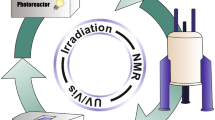Abstract
In this article, we give a detailed derivation of the theoretical sequence leading from molecular data to UV–visible absorption spectra, and back from absorption spectra to molecular data, in the widely encountered case of linearly absorbent molecular species homogeneously and isotropically diluted in a homogeneous and isotropic transparent matrix or solvent. At each step of the derivation, assumptions and approximations are clearly explained and references are provided for the justifications which are out of the scope of the present article. The precision and the limitations of such spectroscopic investigations are then underlined and quantified on two examples: a hypothetic academic one-dimensional system and the \({\rm Ni}({\rm H}_{2}{\rm O})_{6}^{2+}\) aqueous complex. The present interdisciplinary article aims to contribute to more efficient, and more and more necessary, interplays and mutual interactions between theoreticians and experimentalists by providing, to nonspecialists of both sides, a rather complete but clear and accessible description of the previously mentioned bijective sequence.
Similar content being viewed by others
References
Weast RC (1979). Handbook of Chemistry, 60th edn. CRC Press, Boca Raton
Albrecht AC (1960). “forbidden” character in allowed electronic transitions. J Chem Phys 33(1): 156–169
Andrews L and Moskovits L (1989). Chemistry and physics of matrix isolated species. NorthHolland, Amsterdam
Atkins PW and Friedman RS (2001). Molecular quantum mechanics, 3rd edn. Oxford University Press, New York
Bell JE (1981). Spectroscopy in biochemistry, vol 1, 2. CRC Press, Boca Raton
Blachnik R (1998). Elemente, anorganische Verbindungen und Materialen, Minerale, Taschenbuch für Chemiker und Physiker, vol 3, 4th edn. Springer, Berlin
Condon EU and Shortley GH (1991). The theory of atomic spectra. Cambridge University Press, Cambridge
Cotton AF, Wilkinson G, Murillo CA and Bochmann M (1999). Advanced inorganic chemistry, 6th edn. Wiley, New York
Debye PJW (1929). Polar molecules. Dover, New York
Delgass WN, Haller GL, Kellerman R and Lunsford JH (1979). Spectroscopy in heterogenous catalysis. Academic Press, New York
Dodd RE (1962). Chemical spectroscopy. Elsevier Student, Amsterdam
Feynman RP, Leighton RB and Sands M (2005). Feynman lectures on physics, definitive and expanded edition, 2nd edn. Addison Wesley, Redwood City
Fortrie R, Chermette H (2006) Two-photon absorption strength: anew tool for the quantification of two-photon absorption. J Chem Phys 124:204104
Fortrie R and Chermette H (2007). Vibronic quasi-free rotation effects in biphenyl-like molecules. TD-DFT study of bifluorene. J Chem Theor Comput 3(3): 852–859
Fortrie R, Anémian R, Stephan O, Mulatier JC, Baldeck PL, Andraud C and Chermette H (2007). Enhancement of two-photon absorption via oligomerization. a route for the engineering of two-photon absorbers in the visible range. J Phys Chem C 111(5): 2270–2279
Harris DC and Bertolucci MD (1989). Symmetry and spectroscopy. An introduction to vibrational and electronic spectroscopy. Dover Publications, New York
Heisenberg W (1925). Z Phys 33: 879
Herzberg G and Teller E (1933). Vibrational structure of electronic transitions for polyatomic molecules. Z Physik Chem B 21: 410–446
Hollas JM (1982). High resolution spectroscopy. Butterworths, London
Hollas JM (2000). Modern spectroscopy, 4th edn. Wiley, Chichester
Huheey JE, Keiter EA and Keiter RL (1997). Inorganic chemistry: principles of structure and reactivity, 4th edn. HarperCollins, New York
Klöpffer W (1984). Introduction to polymer spectroscopy, polymers/properties and applications, vol 7. Springer, Berlin
Kuhn W (1925). Z Phys 33: 408
Kuzmany H (1998). Solid-state spectroscopy and its applications. Springer, Berlin
Leach AR and Gillet V (2003). An introduction to chemoinformatics. Kluwer Academic, Dordrecht
Lorentz HA (1951) The theory of electrons and its applications to the phenomena of light and radiant Heat. In: Teubner B.G. (ed) Leipzig, 1916. Dover, New York
Maier JP (1989). Ion and cluster ion spectroscopy. Elsevier, Amsterdam
McNaught AD and Wilkinson A (1997). IUPAC compemdium of chemical terminology. The gold book, 2nd edn. Blackwell Science, Oxford
Nakamoto K and McCarthy PJ (1968). Spectroscopy and structrure of metal chelate compounds. Wiley, New York
Onsager L (1936). Electric moments of molecules in liquids. J Am Chem Soc 58(8): 1486–1493
Orr BJ and Ward JF (1971). Perturbation theory of the non-linear optical polarization of an isolated system. Molec Phys 20: 513–526
Perkampus HH (ed) (1995) Encyclopedia of spectroscopy. VCH, Weinheim
Reiche F and Thomas W (1925). Z Phys 34: 510
Roche M and Jaffé HH (1974). A modification of the Herzberg-Teller expension for vibronic coupling. J Chem Phys 60(4): 1193–1196
Sierka M and Sauer J (2000). Finding transition structures in extended systems: a strategy based on a combined quantum mechanics-empirical valence bond approach. J Chem Phys 112(16): 6983–6996
Spezia R, Duvail M, Vitorge P, Cartailler T, Tortajada J, Chillemi G, D’Angelo P and Gaigeot MP (2006). A coupled Car-Parrinello molecular dynamics and EXAFS data analysis investigation of aqueous co2+. J Phys Chem A 110(48): 13081–13088
Thomas W (1925). Naturwiss 13: 627
Vollhardt KPC and Shore NE (1994). Organic chemistry. 2nd edn. Freeman, New York
Williams DH and Fleming I (1995). Spectroscopic methods in organic chemistry, 5th edn. McGraw Hill, London
Author information
Authors and Affiliations
Corresponding author
Additional information
This paper is dedicated to the 60th birthday of Nino Russo.
Rights and permissions
About this article
Cite this article
Fortrie, R., Chermette, H. Quantitative derivation of the bijective link between molecular data and UV–visible absorption spectra for diluted molecules: guidelines for non specialists. Theor Chem Account 120, 363–374 (2008). https://doi.org/10.1007/s00214-008-0411-1
Received:
Accepted:
Published:
Issue Date:
DOI: https://doi.org/10.1007/s00214-008-0411-1




